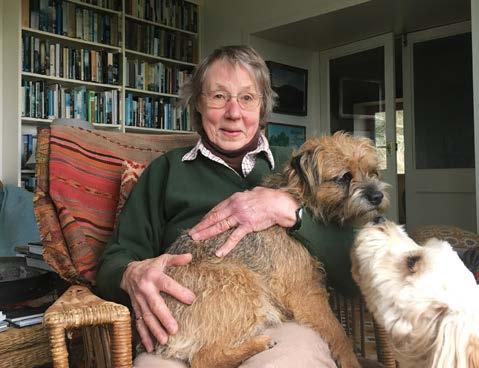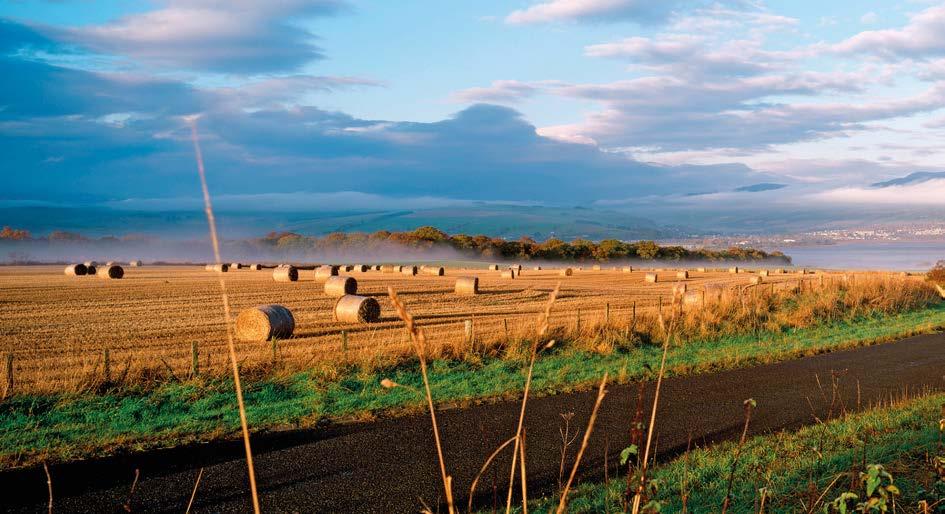
5 minute read
Notes from the isles


Why does anyone ever want to go abroad when they live in the magical Highlands?
Words by KATE FRANCIS
This morning, as I watched an oyster catcher strutting along the beach and a heron eyeing the water for sh, a fellow dog-walker approached.
His summer had been ruined, he moaned: Covid restrictions meant he’d had to cancel a Mediterranean holiday. I commiserated, refraining from comment. Cronie and I then climbed the hill from the shore, up across a meadow carpeted with foxgloves, speedwell, buttercups, daisies, violets and vetch, into woods vibrant with birdsong. We didn’t see the osprey today, but red kites hovered above the trees and a chevron of honking geese ew overhead. I managed to grab Cronie before she spotted the family of roe deer cantering through the trees, and again when a red squirrel ran across the path.
At the top of the hill, I stood among the jumble of rocks, which are all that remain of a Pictish fort – one of many relics in the area of those ‘Painted People’ who caused the Romans to build Hadrian’s Wall to keep them at bay.
Although it was inhabited by Picts, the fort dates back to the Iron Age. History lay all round me. To the south, Loch Ness with its famous inhabitant, who was seen off by St Columba in the 6th century after attacking one of his companions – an act so impressive, it is said, that the Picts converted to Christianity. The battle eld at Culloden Moor to the east, where Bonnie Prince Charlie met his fate, is still preserved, with an excellent visitor centre that offers a

ve-minute lm of the battle that’s so good I could watch it a hundred times. To the west, Ben Wyvis, the only ‘Munro’ in Easter Ross, dominates the skyline; keen eyes will see traces of snow in its gullies year round. It was a kinsman of the Munros who, in 1891, compiled a list of all Scottish hills over 3,000 feet, hence their name; ever since, climbers have competed in Munro bagging.
For shermen, there are rivers and lochs teeming with salmon and trout and a sea full of sh to be hauled in by the bucketful, from mackerel and red gurnard to lobsters and crabs. Mussels cling to the rocks, cockles can be dug up from the sand, shrimps can be caught in nets. For sailors with a good chart and reasonable navigational skills, nothing could match the unbelievable beauty of the west coast and the outer isles, easily accessible from here via the Caledonian Canal. And who wants a beach crammed with people, deckchairs and parasols if they can skinny dip in a remote hill loch or run down a deserted beach and dive into the sea where dolphins frolic in the waves. Those seeking guaranteed sunshine will get guaranteed crowds of people thronging every attraction.
Who would want to go abroad when they live in the magical Highlands?
I’ve been trying to tame my wild garden. As I struggle to rescue cuttings of ‘proper’ plants from being swamped by voracious natives, I think of Charles Darwin’s Evolution theories. I was reminded of this recently driving past the Hugh Miller Birthplace Cottage and Museum in Cromarty. One of Scotland’s great men, Miller was born in 1802 and, among his many accomplishments, he was a geologist, a writer and deeply religious. Some of the fossils he discovered in rocks along the eastern shore dated back more than 400 million years. He died of suicide at the age of 54, partly because he couldn’t equate his strong Christian faith with Darwin’s theories.
Gardening certainly exercises the brain, as well as the muscles. If evolution is ‘survival of the ttest’, I mutter to myself as I rip out the goose grass, docks, nettles and bindweed, wouldn’t it be best if I stopped trying to interfere and let nature take over my garden? And if weeds evolved from less hardy plants, does this explain why mankind, another product of evolution, is by no means perfect and often extremely harmful? With a nod to evolution, I’ve resisted cutting out the suckers from the cultivated rose bushes, so most of them have reverted to their ancestry, sprouting rampant briars. They ower abundantly and look lovely, though I have to confess that I rather miss some of the conquered aristocrats.
Two widow friends came to stay recently, keen gardeners and both in the second half of their 80s. One of them likes a neat, controlled garden: clumps of well spaced plants, elegant shrubs, not a weed in sight, velvet lawns with trimmed edges. The other shares my ‘survival of the ttest’ approach. On their rst day, I left them in the sunroom with the newspapers, while Cronie and I went for our afternoon hike. I returned to nd them both on hands and knees on my terrace, armed with kitchen knives, trying to dig out the invasive weeds between the granite ag stones. As I came through the gate, I heard: “no, no, Jill, don’t dig up that moss, it’s much prettier than bare earth, and leave those little pink rock plants; just take out the uglier and bigger weeds...”. One half of my terrace is now naked, the other is like a charming horizontal rockery. Some neighbours two elds away recently inherited a peacock – Lord Fandango, nicknamed Ponty. Thinking he might be lonely, they bought him a mate, Priti (Patel?) For some reason, the pair didn’t hit it off and Priti ran away to an adjacent farm. Very sadly, she then ventured up onto the main road and was run over by a passing lorry. Ponty has now decided to spread his wings and is testing out a series of local gardens. Each day, the community grapevine reports his latest whereabouts and his owners set off to try and lure him home, but so far without success. I miss his distinctive, if somewhat assertive, call. Once again, I’m found thinking, there’s nowhere more magical than the Highlands of Scotland. S

TOP LEFT:
Kate and Cronie, her faithful Border Terrier
BELOW LEFT:
The view from the Black Isle across the Cromarty Firth to Dingwall and Ben Wyvis










